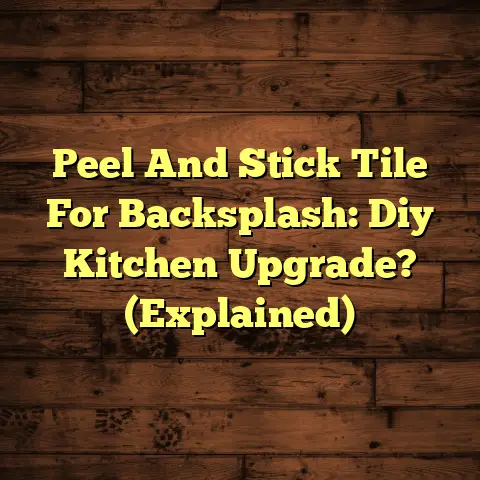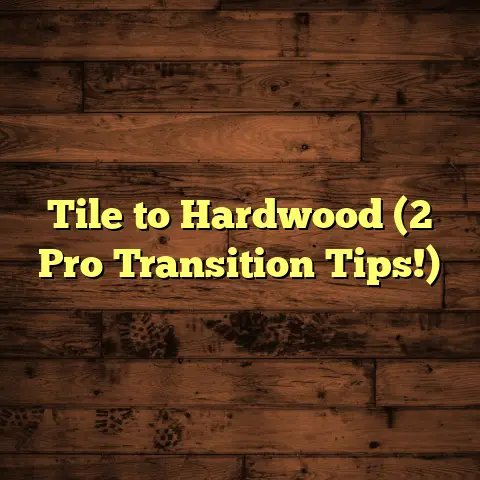Flooring Tips For Rentals? (4 ROI Boosters!)
It’s your friendly neighborhood flooring contractor here, ready to chat about something near and dear to my heart – flooring! But not just any flooring; we’re talking about flooring for rental properties, specifically those welcoming our furry friends.
The Rise of Pet-Friendly Rentals
Let’s face it: pets are family. And more and more renters are looking for places that understand that. According to the American Pet Products Association (APPA), 70% of U.S. households own a pet. That’s a massive market you could be tapping into!
Think about it: happy tenants, longer leases, and potentially higher rental rates. But with pets come challenges, especially when it comes to flooring.
Scratches, stains, accidents – I’ve seen it all!
That’s where smart flooring choices come in. It’s not just about aesthetics; it’s about protecting your investment and maximizing your ROI (Return on Investment).
Flooring and ROI: A Match Made in Heaven
Now, I know what you’re thinking: “Flooring is expensive!” And you’re not wrong. But investing in the right flooring can actually save you money in the long run.
- Reduced Repair Costs: Durable flooring means fewer repairs and replacements.
- Increased Tenant Satisfaction: Happy tenants stay longer, reducing turnover costs.
- Higher Rental Rates: Pet-friendly rentals can command a premium.
- Enhanced Property Value: Quality flooring improves the overall appeal and value of your property.
So, how do you choose the right flooring to boost your ROI? Let’s dive into four key tips!
1. Choosing Durable Flooring
Okay, let’s get down to the nitty-gritty. What flooring materials can actually withstand the wear and tear of pet ownership?
I’ve got three words for you:
- Luxury Vinyl Plank (LVP)
- Tile
- Laminate
These are the MVPs of pet-friendly flooring, and here’s why:
Luxury Vinyl Plank (LVP)
LVP is a synthetic flooring designed to mimic the look of hardwood or stone. It’s waterproof, scratch-resistant, and relatively affordable.
- Pros:
- Highly durable and resistant to scratches, dents, and stains
- Waterproof, making it ideal for areas prone to accidents
- Easy to clean and maintain
- Available in a wide range of styles and colors
- Comfortable underfoot
- Cons:
- Can be more expensive than some other options
- Not as eco-friendly as some natural materials
- Can feel less luxurious than real hardwood
I’ve seen LVP hold up beautifully in rentals with multiple dogs and cats. Plus, it’s super easy to clean – a quick sweep and mop, and you’re good to go.
Tile
Tile is another excellent choice for pet-friendly rentals. It’s incredibly durable, waterproof, and resistant to scratches and stains.
- Pros:
- Extremely durable and long-lasting
- Waterproof and stain-resistant
- Easy to clean and maintain
- Available in a wide range of styles, colors, and sizes
- Can add value to your property
- Cons:
- Can be cold and hard underfoot
- Can be slippery when wet
- Installation can be more complex and expensive
- Grout can be prone to staining
I recommend using larger tiles with minimal grout lines to reduce the risk of staining. And consider adding rugs for warmth and comfort.
Laminate
Laminate flooring is a synthetic material that mimics the look of hardwood. It’s more affordable than hardwood but still offers good durability and scratch resistance.
- Pros:
- More affordable than hardwood or LVP
- Durable and scratch-resistant (look for high AC rating)
- Easy to clean and maintain
- Available in a wide range of styles and colors
- Cons:
- Not waterproof (water-resistant options are available)
- Can be noisy underfoot
- Less durable than LVP or tile
- Can be susceptible to water damage if not properly installed
When choosing laminate, look for options with a high AC (Abrasion Class) rating. This indicates how well the flooring can withstand wear and tear.
Landlord Testimonial
I once worked with a landlord who had a nightmare experience with carpet in a pet-friendly rental. After countless stains and repairs, he finally switched to LVP.
He told me, “It was the best decision I ever made! My tenants love it, and I haven’t had to worry about flooring issues since.”
Visual Appeal
Durability is key, but don’t forget about aesthetics! Choose flooring that is both pet-friendly and visually appealing to potential tenants.
After all, you want your rental to stand out from the crowd.
2. Flooring Treatments and Finishes
So, you’ve chosen your durable flooring. Great! But you can take things a step further with the right treatments and finishes.
These can enhance the longevity and appearance of your flooring, protecting it from pet-related damage.
Sealants
Sealants create a protective barrier on the surface of your flooring, preventing liquids from penetrating. This is especially important for grout lines in tile flooring.
- Types of Sealants:
- Penetrating sealants: These soak into the grout and provide long-lasting protection.
- Surface sealants: These create a film on the surface of the grout.
- Application:
- Clean the grout thoroughly.
- Apply the sealant according to the manufacturer’s instructions.
- Allow the sealant to dry completely before using the area.
I recommend resealing grout every one to two years to maintain its protective properties.
Scratch-Resistant Coatings
Scratch-resistant coatings can be applied to LVP and laminate flooring to further protect against scratches and scuffs.
- Types of Coatings:
- Polyurethane coatings: These provide a durable, scratch-resistant finish.
- Acrylic coatings: These are more affordable but less durable.
- Application:
- Clean the flooring thoroughly.
- Apply the coating according to the manufacturer’s instructions.
- Allow the coating to dry completely before using the area.
Keep in mind that no coating is completely scratch-proof. But these treatments can significantly reduce the risk of damage.
Stain Repellents
Stain repellents can be applied to various flooring types to prevent stains from setting in. This is particularly useful for carpets and rugs.
- Types of Repellents:
- Fluorochemical-based repellents: These provide excellent stain protection.
- Silicone-based repellents: These are more affordable but less effective.
- Application:
- Clean the flooring thoroughly.
- Apply the repellent according to the manufacturer’s instructions.
- Allow the repellent to dry completely before using the area.
I always recommend testing stain repellents in an inconspicuous area before applying them to the entire floor.
Professional Insights
I spoke with a property manager recently who swears by these treatments.
She said, “Investing in sealants and scratch-resistant coatings has saved me thousands of dollars in repair costs. It’s a no-brainer for pet-friendly rentals.”
3. Color and Texture Considerations
Okay, let’s talk aesthetics! The color and texture of your flooring can play a big role in how well it holds up in a pet-friendly rental.
Darker Colors
Darker colors, such as browns, grays, and blacks, are excellent at hiding pet hair and stains. They also tend to be more forgiving when it comes to scratches and scuffs.
Think about it: a dark hardwood floor will hide pet hair much better than a light-colored one.
Multi-Tonal Patterns
Multi-tonal patterns, such as wood-look planks with varying shades and grains, can also help to camouflage pet hair and imperfections.
These patterns add visual interest and make it harder to spot dirt and debris.
Texture
Texture can play a role in both aesthetics and functionality. Textured flooring can help to conceal scratches and wear over time.
For example, a distressed wood-look LVP will hide scratches better than a smooth, glossy one.
Successful Combinations
I’ve seen some amazing color and texture combinations in pet-friendly rentals. Here are a few of my favorites:
- Dark gray tile with a textured finish
- Multi-tonal brown LVP with a wood-grain pattern
- Dark brown laminate with a hand-scraped texture
These combinations are both stylish and practical, making them a win-win for landlords and tenants.
4. Easy Maintenance and Cleanability
Last but not least, let’s talk about maintenance. After all, no matter how durable your flooring is, it will still require regular cleaning.
Maintenance Routines
Here are some tips for maintaining different flooring types in pet-friendly rentals:
- LVP: Sweep or vacuum regularly to remove pet hair and debris. Mop with a mild detergent and water as needed.
- Tile: Sweep or vacuum regularly. Mop with a tile cleaner and water. Clean grout lines with a grout brush and cleaner.
- Laminate: Sweep or vacuum regularly. Mop with a laminate cleaner and water. Avoid using excessive water, as this can damage the flooring.
Recommended Products
When choosing cleaning products, look for options that are safe for use around pets. Avoid harsh chemicals that could be harmful if ingested.
I recommend using enzyme-based cleaners to remove pet odors and stains. These cleaners break down the organic compounds that cause odors, leaving your rental smelling fresh and clean.
Tenant Satisfaction
Easy maintenance is key to tenant satisfaction. Tenants are more likely to take care of flooring if it’s easy to clean and maintain.
This can lead to higher tenant retention rates and fewer headaches for you.
Tenant Insights
I once spoke with a tenant who had lived in a rental with carpet. She said, “It was a nightmare! I was constantly cleaning up pet messes, and the carpet always smelled like dog. I would never rent another place with carpet.”
This highlights the importance of choosing flooring that is easy to clean and maintain.
Conclusion
So, there you have it: four flooring tips that can boost your ROI in pet-friendly rentals.
By investing in durable flooring, treatments, and maintenance practices, you can protect your investment, attract and retain tenants, and increase the value of your property.
- Choose durable flooring materials like LVP, tile, or laminate.
- Apply sealants, scratch-resistant coatings, and stain repellents.
- Consider darker colors and multi-tonal patterns to hide pet hair and stains.
- Select flooring that is easy to clean and maintain.
Now, I challenge you to assess your current flooring and consider how these tips can be applied to improve your rental properties. Your tenants (and their furry friends) will thank you for it!





